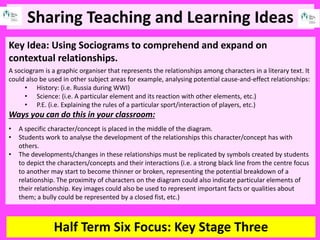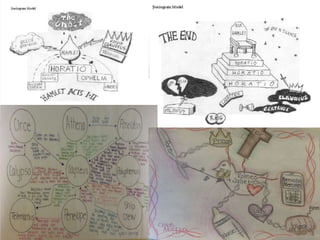Key stage three 3
- 1. Sharing Teaching and Learning Ideas Half Term Six Focus: Key Stage Three Key Idea: Using Sociograms to comprehend and expand on contextual relationships. A sociogram is a graphic organiser that represents the relationships among characters in a literary text. It could also be used in other subject areas for example, analysing potential cause-and-effect relationships: âĒ History: (i.e. Russia during WWI) âĒ Science: (i.e. A particular element and its reaction with other elements, etc.) âĒ P.E. (i.e. Explaining the rules of a particular sport/interaction of players, etc.) Ways you can do this in your classroom: âĒ A specific character/concept is placed in the middle of the diagram. âĒ Students work to analyse the development of the relationships this character/concept has with others. âĒ The developments/changes in these relationships must be replicated by symbols created by students to depict the characters/concepts and their interactions (i.e. a strong black line from the centre focus to another may start to become thinner or broken, representing the potential breakdown of a relationship. The proximity of characters on the diagram could also indicate particular elements of their relationship. Key images could also be used to represent important facts or qualities about them; a bully could be represented by a closed fist, etc.)

